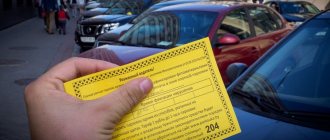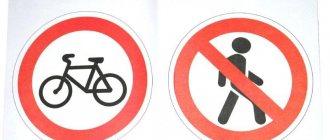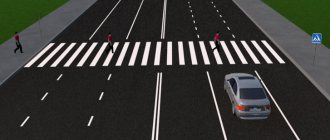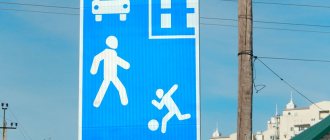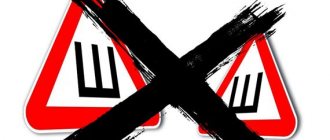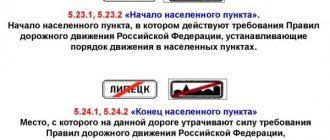A pedestrian zone sign marks a separate area in order to ensure the safe movement of pedestrians. It is often confused with other similar designations, which leads to violation of traffic rules. Drivers risk running into a fine of 500 rubles, since the movement of any type of transport in the area of the sign without additional signs is strictly prohibited. But there is also a sign “Pedestrian traffic is prohibited.”
From the article you can find out how the zone is designated and how it differs from a pedestrian path. It is described when the ban on placing vehicles in a zone does not apply and whether it is possible to drive without violations to the territory where the sign is in force. Various options for recording violations and answers to readers’ questions on the topic are also provided.
Purpose and coverage area of sign 5.33 “Pedestrian zone”
Mandatory pedestrian zone sign. It establishes a special regime, mandatory for all citizens in the area designated by it.
The term is defined by clause 1.2 of the Rules. They designate the territory in a populated area where citizens have the right to move exclusively on foot.
Such a zone begins with road sign 5.33. To determine the end of the pedestrian zone, sign 5.34 is used.
The first is presented in the form of a rectangular plate, in the middle of which there is a circle with a blue background. It depicts the silhouette of a person. At the top above the circle is the inscription “Zone”. Most often, an additional image of a red “snowflake” is placed.
The city usually adds 8.5 signs. They determine the duration of the sign - a clear time period, a specific day or month.
How traffic rules interpret sign 5.33
According to the traffic rules, this is the definition of an area allocated specifically for the movement of pedestrians exclusively.
Accordingly, any movement in the area covered by the specified road sign - cars - is prohibited:
- The main feature of the sign in question is that it can be used to indicate a traffic area only in conjunction with another sign. We are talking about a sign, which in the traffic rules is designated by the number 5.34 and warns about the end of the road section for pedestrians. Thus, when the beginning of the territory for pedestrians is indicated by sign 5.33, then at the end of this zone there must be sign 5.34.
- It should be noted that the road sign in question can be installed at the beginning of the pedestrian zone together with additional information signs. In the traffic rules they are listed under number 8.5.
Additional signs warn walkers that the ban on motor vehicles is only valid at certain times of the day or day of the week.
When the main sign is supplemented by an information plate with an asterisk on it, this reminds pedestrians that the sign applies only to weekends or holidays.
Differences between the “Pedestrian zone” and the “Pedestrian path”
Externally, the signs are quite similar and, moreover, both impose a ban on traffic within their range.
However, there are differences between them:
- A pedestrian path is created intentionally for pedestrians, planning it in advance. Whereas a zone is a modified territory adapted for pedestrians, which can be a section of a road. This includes both curbs and adjacent sidewalks. Indicated by the sign “Pedestrian path”.
- Despite the fact that vehicles are prohibited from moving along the path for pedestrians, exceptions are provided. Thus, the established rule can be legally violated by municipal and road maintenance structures if it is necessary to carry out certain work with the participation of special vehicles. In addition, vehicle access is permitted if it is related to loading and unloading of goods, but provided there is no alternative route. As for driving through the pedestrian zone, there is a mandatory rule. If there are no additional signs establishing the expiration period of the sign, vehicles, including mechanical ones, must not violate the restrictions.
- The path for citizens traveling on foot is marked with only one sign at the beginning of the action - 5.4. It ends when it intersects with any road. In turn, two separate signs are provided to mark the beginning and end of the pedestrian zone.
Pedestrian zone or pedestrian path - differences
To understand this issue, you should carefully study the traffic rules. So, in addition to the road sign in question, you can also find a sign numbered 5.4 in the set of road rules. And if, at first glance, the interpretation of both signs is clear even to motorists without much experience and experience, then, delving into the study of the issue, you can find a lot of differences between them.
What is the main difference between a “track” and a “zone”?
In the first case, a separate road is provided for the movement of pedestrians, along which they can walk. To create an area for walking excursions, one road will not be enough. For these purposes, a much larger area is used, which, in most cases, can occupy the entire roadway along with the sidewalk and curbs.
There are also differences in the designation of both areas of pedestrian traffic:
- The path sign is installed exclusively at the beginning of the pedestrian traffic zone.
- This road sign ends at the first intersection of the path and a full-fledged highway.
- The pedestrian zone is designated from the moment it begins to the end. That is, even if there is an intersection with a highway along the pedestrian zone, the effect of the sign does not end.
There is another small but very important difference.
Quite often, a place for walking is associated with a large concentration of shops and a wide variety of organizations, for the functioning of which the uninterrupted supply of industrial and food products is vital. In addition, walking areas are constantly in need of cleaning by city utilities. For these reasons, the movement of special equipment, as well as vehicles for unloading and loading operations, in the absence of other access options, along pedestrian paths is permitted.
For sections of the road fenced with signs 5.33 and 5.34, absolutely any movement of vehicles is strictly prohibited.
That is, all actions that are partially permitted on pedestrian paths are prohibited in the area covered by the “Pedestrian Zone” sign.
Penalty for driving in a pedestrian zone
If traffic regulations are not followed and sign restrictions are ignored, the culprit faces administrative liability.
It would be a mistake to assume that the violation will be qualified under Part 12.15 of the Administrative Code. This article does not indicate the pedestrian zone and the corresponding restrictions.
Attention should be paid to Article 12.16 of the Administrative Code. The punishment for it is less.
The article punishes drivers who do not comply with the requirements established by road signs.
There are several sanctions. The least involves only warning the violator. More severe - a fine for driving within the limits of the sign. The driver will have to pay 500 rubles for inattention. The difference is noticeable, because in the first case a fine of 1.5 thousand rubles is expected. more.
Drivers should be aware of this feature, since inspectors can take advantage of drivers’ ignorance of the nuances of traffic rules.
According to the traffic rules, what is prohibited in the area covered by the “Pedestrian zone” sign?
The location where this sign is activated will create convenient conditions for people on foot, making their movement status a priority. Installation takes place in the following areas:
- Prohibition of active traffic;
- crossing safety.
Sign 5.33 is used with a duplicate paired sign, which indicates the end of the zone for pedestrians.
When the start of the pedestrian zone is marked, the driver must maneuver carefully. The sign is often used in conjunction with duplicate signs:
- The validity of the sign in a certain time period;
- an asterisk under the graphic indicates 5.33 activity on certain calendar days.
Who is allowed to move in the area covered by sign 5.33
If the “Pedestrian zone” sign is used without additions to it, there is a complete restriction of the movement of any type of transport on the territory. You can only move within the sign's coverage area on foot. Any violations entail liability.
When it is necessary to free part of the city from traffic at a certain time, this sign is temporarily installed.
If signs 8.5 are used with a sign, it prohibits vehicles from moving through the territory only at certain times.
For example, a red o at the bottom of the sign means that restrictive measures are in effect only on weekends and holidays.
During other periods not covered by additional marks, movement is permitted.
The only amendment concerns tram and pedestrian streets. If such a sign is installed on them, trams, in addition to pedestrians, can move along the street.
Effect of the “Pedestrian zone” sign
According to the requirements of the Traffic Regulations, territory 5.33 “Pedestrian zone” is an area marked with special signs in which the movement of any wheeled vehicles is prohibited, leaving priority only to pedestrians. The sign looks like a rectangular sign with a blue circle in the middle containing a picture of a person. Above the circle is the inscription “Zone”, under the circle there is a red snowflake/star.
A special feature of sign 5.33 is its use to indicate the start of movement for pedestrians only in conjunction with any additional sign, especially in conjunction with sign 5.34. The latter is used to warn about the end of a section of the pedestrian zone.
The sign in question can be placed at the beginning of a section of a pedestrian crossing with duplicate signs.
The addition to 5.33 is the 8.5 pointers. Their purpose is to warn pedestrians that vehicles are prohibited on the path with the following conditions:
- On specialized sections;
- at a specified time of day or calendar day.
Sign 8.5.1 - “Saturdays, Sundays and holidays”
How is an offense recorded?
Employees of the State Traffic Inspectorate and the patrol service can record a violation. Violations are often recorded using automated cameras.
However, recently, notifications from law-abiding citizens have increasingly become the reason for considering cases of administrative violations.
Any citizen, whether a pedestrian or a driver, has the right to record a violation of the Rules himself if he has become an involuntary witness. Usually photo or video recording is used. The materials are handed over to law enforcement officers.
You can contact the inspectorate in person, send an application by mail or online.
The popularity of using a special application on mobile devices is also increasing. The program's functions allow you to record evidence with a guarantee of its originality, report information about the citizen who committed the violation, and even receive bonuses.
What does the Pedestrian Zone sign mean?
With the advent of cars, the freedom of movement of walkers was gradually limited. The most spacious and level parts of the road began to be allocated for vehicles. Pedestrians had to make do with what was left - small narrow sidewalks.
In small towns and villages, where there is little motor transport, there have almost never been any problems with places for walking and there are none today. But in megacities with their eternal traffic jams, the average pedestrian has to almost literally press against the walls of houses on the side of the road.
To solve this problem, some parts of the street that were previously passable were eventually returned to people, prohibiting any transport from moving on this territory except:
- municipal equipment;
- cash-in-transit and other official vehicles;
- bicycles;
- hoverboards.
Such areas are called “pedestrian zones”. They first appeared in Europe in the fifties of the twentieth century.
In order for drivers to know which streets are not intended for driving, a specialized road sign “Pedestrian zone” was introduced.
By the way, the territories indicated by this sign are not always roads. They often include one or more streets, as well as squares.
"Crosswalk"
Sometimes, the sign in question 5.33 is correlated with the sign “Pedestrian crossing area” (code 5.19.1).
Apart from a similar name, they have little in common. The fact is that the “Pedestrian Crossing” sign is used to designate small gaps on the roadway where people can cross it. However, in contrast to the area intended for walking and promenading, the coverage area of the “Pedestrian Crossing” sign is allocated for safe, and most importantly, quick crossing of the roadway. You cannot walk, stop or just walk here. Like the entire road, this area is primarily intended for cars, with the only difference being that pedestrians can pass through here.
Although the space designated by the “Pedestrian Zone” sign is much safer for people than a pedestrian crossing, care must be taken here too. After all, no one has canceled official transport, cyclists and simply careless pedestrians. And they are also capable of causing injury. Therefore, wherever you are, do not lose your vigilance, take care of yourself and your family.

